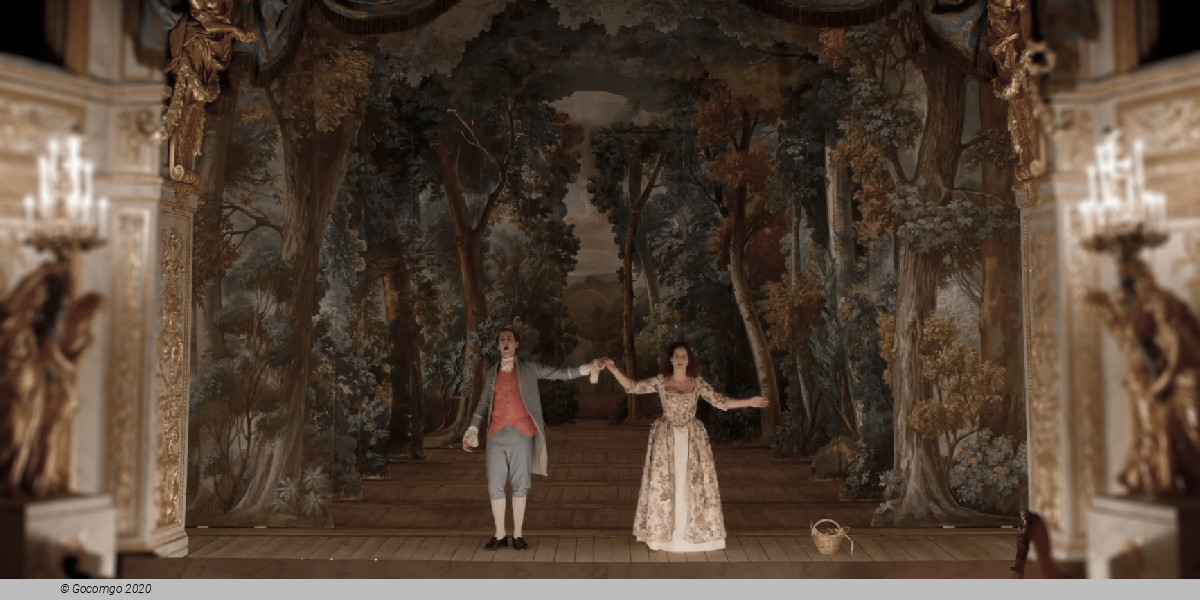Queen’s Theatre (Paris, France)
Queen’s Theatre

A great lover of the dramatic arts, Marie-Antoinette eventually grew tired of the temporary stages knocked together for performances in the gallery of the Grand Trianon and the orangery of the Petit Trianon. Once she had decided to commission her personal architect Richard Mique to build her a real theatre, work was completed in spring 1780, and the official inauguration was on 1 June.
Cleverly tucked away amidst the foliage of the gardens, the entrance to the theatre is a discreet portico in the classical style. The theatre itself was large enough to seat two hundred and fifty spectators, in a décor dominated by blue, white, and gold. The sculpted decorations were created using the quick (and cheap) technique of papier mâché, in which the craftsmen of the Menus Plaisirs were acknowledged, experts. The various shades of gold blend harmoniously with the false marble paneling dominated by violet tones. The ceiling, painted by Lagrenée, was completed just a few days before the inauguration of the theatre and depicted Apollo surrounded by the Graces and Muses. The original was replaced by a copy in the 19th century. The vast stage (eight layers, two floors below stage level and two in the rafters), was expertly fitted out by mechanical specialist Pierre Boullet, successor to Blaise-Henri Arnoult, who designed the machinery of the Royal Opera. The orchestra pit has room for around twenty musicians.
The queen intended the Trianon theatre to play a double role: it needed to provide a stage for the works commissioned from the artist of the Royal Academy of Music, and thus offer satisfactory technical facilities, but it also needed to allow the queen to indulge her passion for amateur dramatics and to put on comedies with her friends whenever she fancied. Between 1780 and 1785 Marie-Antoinette used her theatre for both purposes. She commissioned new works which reflected her interest in the music of the day. Featured artists included Gluck, Grétry, Sacchini, and Paisiello, whose Barber of Seville, first performed in Saint Petersburg for Catherine II, had its French premiere at the Trianon theatre in 1784. Falling out of favor with the queen after 1785, the theatre survived the revolutionary period relatively unscathed. It was used occasionally in the nineteenth and early twentieth centuries and underwent restoration between 1925 and 1936 and again in 2001.
The original machinery has been restored to working order, making the Trianon theatre the only eighteenth-century theatre in France which is still intact and fully functioning. Along with an exceptional set dating from 1754 and showing the temple of Minerva from the first act of Quinault and Lully’s Thésée - designed by the Slodtz brothers for the theatre at Fontainebleau - the Queen’s Theatre still has various items of scenery (including two full sets) produced in the nineteenth century by Pierre-Luc-Charles Cicéri and his workshop: a ‘rustic interior’, a forest, and fragments of a public square and ‘rich salon’.
On account of its small size and distance from the palace, the auditorium is no longer used for performances. This has helped to preserve the theatre in its original condition, without the need to install modern safety features which would inevitably compromise its period authenticity. The theatre is still open to the public as part of the guided tour ‘Special effects at the Queen’s Theatre’, which includes a live demonstration of how the sets were changed.


